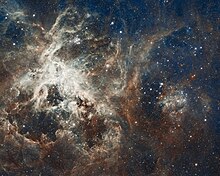Datei:30 Doradus, Tarantula Nebula.jpg

Größe dieser Vorschau: 749 × 599 Pixel. Weitere Auflösungen: 300 × 240 Pixel | 600 × 480 Pixel | 960 × 768 Pixel | 1.280 × 1.024 Pixel | 2.560 × 2.048 Pixel | 20.323 × 16.259 Pixel
Originaldatei (20.323 × 16.259 Pixel, Dateigröße: 99,35 MB, MIME-Typ: image/jpeg)
Dateiversionen
Klicke auf einen Zeitpunkt, um diese Version zu laden.
| Version vom | Vorschaubild | Maße | Benutzer | Kommentar | |
|---|---|---|---|---|---|
| aktuell | 19:35, 8. Jul. 2012 |  | 20.323 × 16.259 (99,35 MB) | Prof. Professorson | Higher resolution, converted from http://spacetelescope.org/static/archives/images/original/heic1206a.tif. |
| 13:13, 19. Apr. 2012 |  | 2.340 × 1.847 (2,52 MB) | Dipankan001 |
Dateiverwendung
Die folgende Seite verwendet diese Datei:
Globale Dateiverwendung
Die nachfolgenden anderen Wikis verwenden diese Datei:
- Verwendung auf af.wikipedia.org
- Verwendung auf ar.wikipedia.org
- Verwendung auf be-tarask.wikipedia.org
- Verwendung auf bn.wikipedia.org
- Verwendung auf crh.wikipedia.org
- Verwendung auf cs.wikipedia.org
- Verwendung auf cv.wikipedia.org
- Verwendung auf en.wikipedia.org
- Tarantula Nebula
- Starburst region
- Talk:Tarantula Nebula
- Wikipedia:WikiProject Astronomy/Recognized content
- Wikipedia:Featured pictures/Space/Looking out
- User:North8000
- Wikipedia:Teahouse/Guests
- Wikipedia:Teahouse/Guest profile summary
- Wikipedia:Teahouse/Guest profile summary/Avatars
- Wikipedia:Teahouse/Guests/Left column
- Wikipedia:Teahouse/Guests/Right column
- User:The Determinator/Userpage/Top/Image
- Wikipedia:WikiProject Astronomy/Recognized astronomy content
- Wikipedia:Teahouse/Guest/Featured/12
- Wikipedia:Teahouse/Guest/Featured/21
- Wikipedia:Teahouse/Guest/Featured/22
- Wikipedia:Teahouse/Guest book/Archive 13
- Wikipedia:Teahouse/Guest book/Archive 14
- Wikipedia:Teahouse/Guest book/Archive 15
- Wikipedia:Teahouse/Guest book/Archive 16
- Wikipedia:Teahouse/Guest book/Archive 17
- Wikipedia:Teahouse/Guest book/Archive 18
- Wikipedia:Teahouse/Guest book/Archive 19
- Wikipedia:Teahouse/Guest book/Archive 20
- Wikipedia:Teahouse/Guest book/Archive 22
- Wikipedia:Teahouse/Guest book/Archive 23
- Wikipedia:Teahouse/Guest book/Archive 26
- Wikipedia:Teahouse/Guest book/Archive 28
- Wikipedia:Teahouse/Guest book/Archive 29
- Wikipedia:Teahouse/Guest book/Archive 30
- Wikipedia:Teahouse/Guest book/Archive 31
- Wikipedia:Teahouse/Guest book/Archive 34
- Wikipedia:Teahouse/Guest book/Archive 35
- Wikipedia:Teahouse/Guest book/Archive 36
- Wikipedia:Teahouse/Guest book/Archive 37
- Wikipedia:Teahouse/Guest book/Archive 39
- Wikipedia:Teahouse/Guest book/Archive 40
- User:LucasTichawa
- Wikipedia:Teahouse/Guest book/Archive 42
- Wikipedia:Teahouse/Guest book/Archive 43
- Wikipedia:Teahouse/Guest book/Archive 44
- Wikipedia:Teahouse/Guest book/Archive 45
Weitere globale Verwendungen dieser Datei anschauen.

